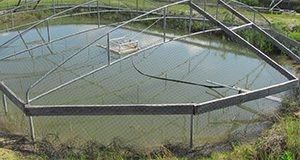Abstract
Non-native species sometimes escape from aquaculture facilities, but producers can prevent these potentially harmful escapes by placing barriers like screens, covers, control structures, and ponds at vulnerable points. Aquaculture producers use these structures to prevent release of non-native species in compliance with Florida Aquaculture Best Management Practices. Further, many of the structures discussed in this 9-page fact sheet are also effective in addressing and maintaining compliance with the discharge requirements of those Best Management Practices. The fact sheet provides escape prevention strategies and advice for building structures and barriers that can keep potentially harmful non-native species safely contained on aquaculture facilities. Written by Quenton M. Tuckett, Carlos V. Martinez, Jared L. Ritch, Katelyn M. Lawson, and Jeffrey E. Hill, and published by the School of Forest Resources and Conservation, Program in Fisheries and Aquatic Sciences, August 2016.
References
FDACS. 2015. Aquaculture Best Management Practices Rule. Florida Department of Agriculture and Consumer Services, Division of Aquaculture, Tallahassee, FL.
Hill, J. E., Q. M. Tuckett, C. V. Martinez, J. L. Ritch, and K. M. Lawson. 2016. Preventing escape of non-native species from aquaculture facilities in Florida, part 2: facility evaluation strategies. FA196. Gainesville: University of Florida Institute of Food and Agricultural Sciences. http://edis.ifas.ufl.edu/fa196
Hill, J.E., and C.L. Ohs. 2015. Stormwater Detention and Discharge from Aquaculture Ponds in Florida. Gainesville: University of Florida Institute of Food and Agricultural Sciences. BUL334. Gainesville: University of Florida Institute of Food and Agricultural Sciences. http://edis.ifas.ufl.edu/fa158.
Shireman, J. V., and C. E. Cichra. 1994. "Evaluation of aquaculture effluents." Aquaculture 123:55-68. https://doi.org/10.1016/0044-8486(94)90119-8
Wilson, C., L. Scotto, B. Boman, and T. Gaver. 2012. Flatwoods Citrus Best Management Practice : Riser-Board Structures. SL-196. Gainesville: University of Florida Institute of Food and Agricultural Sciences. http://edis.ifas.ufl.edu/ss409.
Tuckett, Q. M., C. V. Martinez, J. L. Ritch, K. M. Lawson, and J. E. Hill. 2016a. Preventing escape of non-native species from aquaculture facilities in Florida, part 1: general considerations and regulations. FA195.Gainesville: University of Florida Institute of Food and Agricultural Sciences. http://edis.ifas.ufl.edu/fa195.
Tuckett, Q. M., C. V. Martinez, J. L. Ritch, K. M. Lawson, and J. E. Hill. 2016b. Preventing escape of non-native species from aquaculture facilities in Florida, part 4: operational strategies. FA198. Gainesville: University of Florida Institute of Food and Agricultural Sciences. http://edis.ifas.ufl.edu/fa198.
Tuckett, Q. M., J. L. Ritch, K. M. Lawson, and J. E. Hill. 2014. Best management practices and escapement of non-native fish from aquaculture facilities in Florida. Final Report. Florida Department of Agriculture and Consumer Services. Tallahassee, Florida.
Tuckett, Q. M., J. L. Ritch, K. M. Lawson, and J. E. Hill. 2016c. "Implementation and Enforcement of Best Management Practices for Florida Ornamental Aquaculture with an Emphasis on Nonnative Species." North American Journal of Aquaculture 78:113-124. https://doi.org/10.1080/15222055.2015.1121176

